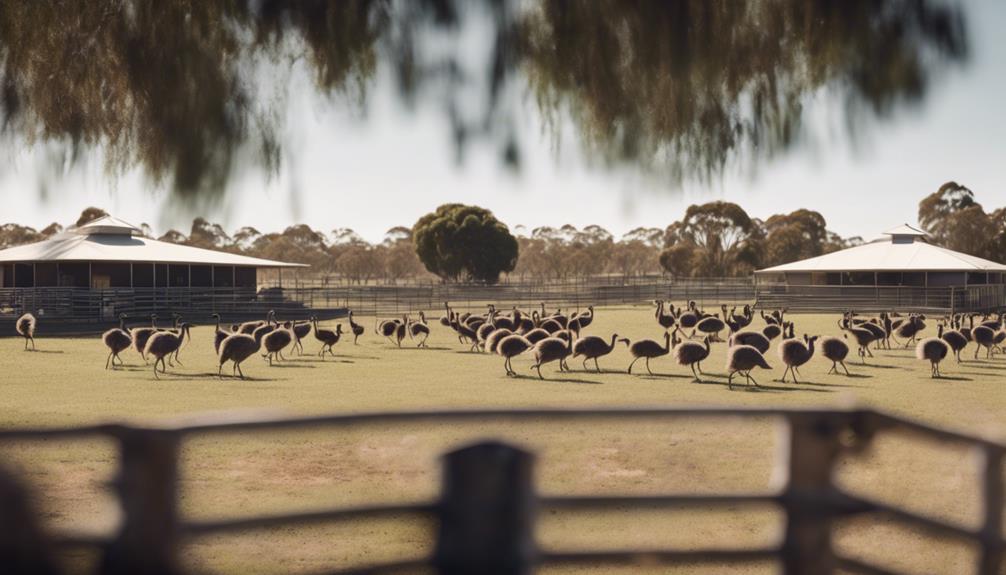
When setting up your Emu farm, did you know that the layout and design can directly impact the productivity and well-being of your flock? Considering factors like farm size, pen arrangements, feeding stations, and health zones is just the beginning. Finding the optimal balance between these elements not only ensures the efficiency of your operations but also plays a significant role in the overall success of your Emu farming venture. Ready to explore how each aspect contributes to creating a harmonious environment for your emus?
Key Takeaways
- Allocate at least half an acre per breeding pair for optimal grazing.
- Implement strategic pen layouts for efficient space utilization.
- Place feeding and watering stations for easy access and monitoring.
- Design pathways with proper drainage and wide width for smooth movement.
- Incorporate sturdy shelter structures with proper ventilation and shade.
Farm Size Considerations

When determining the size of your emu farm, consider the land requirements for optimal breeding and grazing conditions. Emus need ample space to move around freely, especially during their breeding season. A general rule of thumb is to allocate at least half an acre of land per breeding pair of emus. This ensures they've enough room to mate, build nests, and care for their young without feeling cramped.
In addition to breeding space, you must also account for grazing areas. Emus are large birds that require a significant amount of vegetation to graze on. The more emus you have on your farm, the larger the grazing area needs to be to sustain them. It's essential to rotate grazing areas to prevent overgrazing and ensure a continuous food supply for your birds.
Pen Layout Options
Considering the efficient use of space and the well-being of your emus, various pen layout options can be explored to suit your farm's specific needs and requirements. One common layout is the circular pen design, which allows for easy monitoring of emus and efficient feeding practices. The circular shape minimizes corners where emus can become trapped or hide, ensuring better visibility and management.
Another option is the rectangular pen layout, which provides a more linear space for emus to move around. This design can be beneficial for larger flocks, as it allows for easier tracking of individual birds and facilitates the implementation of feeding and watering stations along the length of the pen.
Additionally, a combination of both circular and rectangular pens can be utilized to create a versatile layout that caters to different requirements within your emu farm. By strategically placing these pens, you can optimize space utilization, streamline daily operations, and enhance the overall efficiency of your emu farming venture.
Efficient Feeding Stations

To optimize your emu farm's feeding efficiency, strategically place feeding stations throughout the pens to ensure easy access for all birds. Consider locating the feeding stations in areas with minimal traffic to reduce crowding and competition during feeding times. Each feeding station should be equipped with sturdy feeders that can withstand the pecking and nudging of emus. Ensure that the feeders are at an appropriate height for the birds to reach comfortably, typically around 40-50 inches above ground level.
When designing the feeding stations, take into account the number of emus in each pen to avoid over-crowding. It's recommended to have one feeding station for every 10-15 emus to prevent aggression and ensure all birds have equal access to feed. Additionally, regularly monitor and adjust the placement of feeding stations based on the behavior of the emus to optimize feeding efficiency.
Watering System Placement
Place the watering systems strategically throughout your emu farm to ensure all birds have easy access to fresh water at all times. Emus require a significant amount of water daily, especially during hot weather or breeding seasons. Install multiple watering stations to prevent overcrowding and ensure each bird can drink without competition. Consider placing waterers near feeding areas but away from nesting grounds to minimize contamination risks.
Opt for automatic or self-filling waterers to reduce labor and ensure a continuous water supply. Position the waterers at varying heights to accommodate emus of different sizes, from chicks to adults. Regularly check and clean the watering systems to maintain water quality and prevent the spread of diseases. Additionally, monitor water levels to prevent shortages, especially during peak consumption periods.
Proper placement of watering systems is crucial for the health and well-being of your emus, so plan strategically to meet their hydration needs efficiently.
Pathway Design for Emus
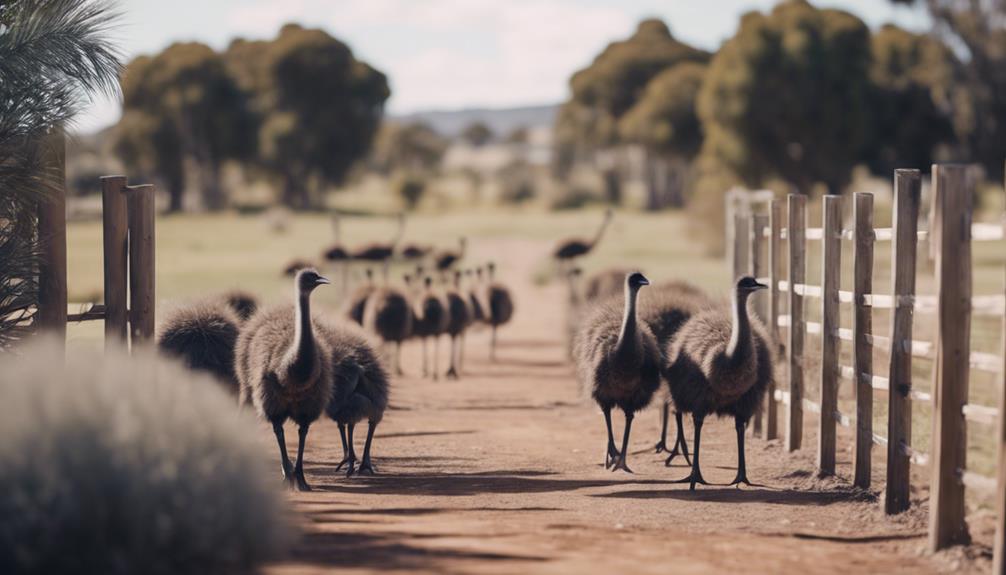
When designing pathways for your emu farm, ensure they are wide enough to accommodate the size of adult emus comfortably. Emus are large birds that require ample space to move around without feeling restricted. A pathway width of at least 8 feet is recommended to allow multiple emus to pass each other without crowding or causing stress. Additionally, the pathways should be constructed with materials that are durable and easy to clean, such as concrete or compacted gravel, to withstand the weight and movement of the emus.
To further guide you in designing pathways for your emu farm, refer to the table below which outlines key considerations for optimal pathway design:
| Pathway Design Considerations | Description |
|---|---|
| Width | Ensure pathways are at least 8 feet wide for ease of movement. |
| Surface Material | Choose durable materials like concrete or compacted gravel. |
| Drainage | Implement proper drainage to prevent water accumulation. |
| Curvature | Minimize sharp turns to allow smooth navigation for emus. |
| Maintenance | Regularly inspect and clean pathways to ensure safety. |
Shelter and Shade Structures
Consider incorporating sturdy shelter and shade structures within your emu farm layout to provide protection from harsh weather conditions and ensure the well-being of your emus. Emus are sensitive to extreme temperatures and can suffer from heat stress or hypothermia if not adequately sheltered. When designing your shelter and shade structures, prioritize durability and functionality. Opt for materials that can withstand the elements and are easy to clean and maintain.
For shelter, you may consider building simple but robust structures such as three-sided sheds or enclosed barns where emus can seek refuge during inclement weather. Ensure proper ventilation to prevent the buildup of moisture and ammonia levels that could compromise the health of your emus.
In addition to shelter, provide ample shade structures in outdoor areas to protect your emus from direct sunlight. This can include natural shade from trees or man-made structures like shade sails or awnings. Adequate shade is essential, especially during hot summer months, to prevent heat-related illnesses in your emus. Remember, a well-designed shelter and shade system is crucial for the overall welfare of your emus and the success of your farm.
Fencing Solutions
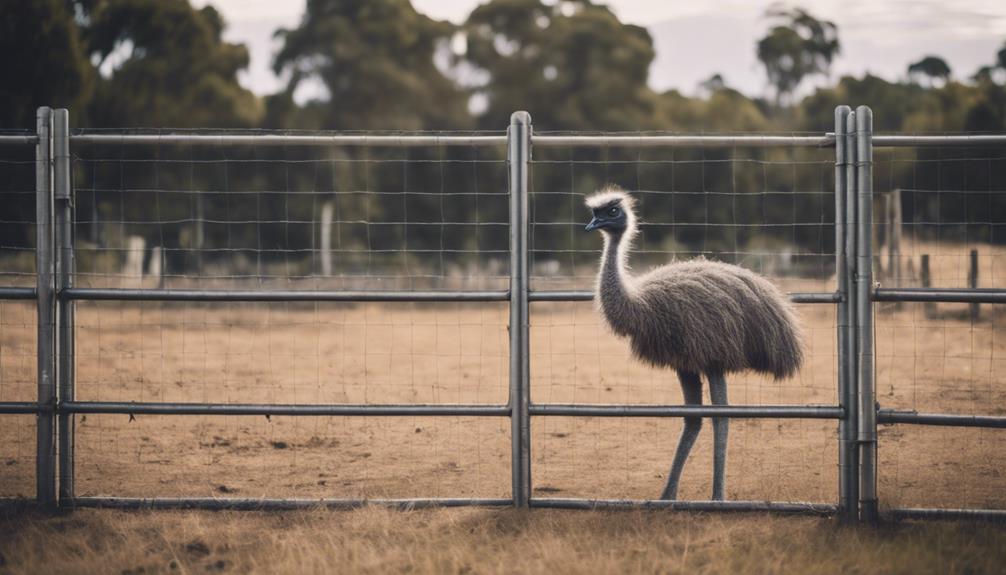
Utilize sturdy fencing solutions to establish secure boundaries around your emu farm, ensuring the safety and containment of your emus. Emus are large, powerful birds that require robust fencing to prevent escapes and protect them from predators. When selecting fencing for your emu farm, opt for materials like high-tensile wire, chain link, or welded wire mesh with a minimum height of 6 feet to deter emus from attempting to jump over. Ensure that the fencing is securely anchored into the ground to prevent burrowing under.
Consider electric fencing as an additional deterrent, especially if you're in an area prone to predators. Electric fencing can deliver a mild shock to predators or curious emus, reinforcing the boundaries of your farm. Regularly inspect the fencing for any damage or weak spots, repairing them promptly to maintain the integrity of the enclosure.
Additionally, implement gates that are large enough to allow easy access for vehicles and equipment, but secure enough to prevent unauthorized entry. By investing in quality fencing solutions, you can create a safe and secure environment for your emus.
Waste Management Strategies
To effectively manage waste on your emu farm, establish efficient disposal systems that prioritize cleanliness and sanitation throughout the farming operation. Start by designating specific areas for waste disposal, such as composting pits for organic waste and designated bins for non-organic materials. Implement a strict waste segregation policy to ensure proper disposal and recycling practices. Regularly inspect these areas to prevent any accumulation of waste that could attract pests or pose health risks.
Consider investing in technologies like biogas digesters to convert organic waste into energy, reducing both waste volume and environmental impact. Implement a routine cleaning schedule for all waste management areas to prevent odors and potential contamination. Properly train farm workers on waste handling procedures to maintain a hygienic environment.
Additionally, establish partnerships with waste management companies for the safe disposal of hazardous materials. Monitor waste production levels regularly to adjust waste management strategies accordingly. By implementing these waste management strategies, you can maintain a clean and efficient operation on your emu farm.
Handling and Sorting Areas
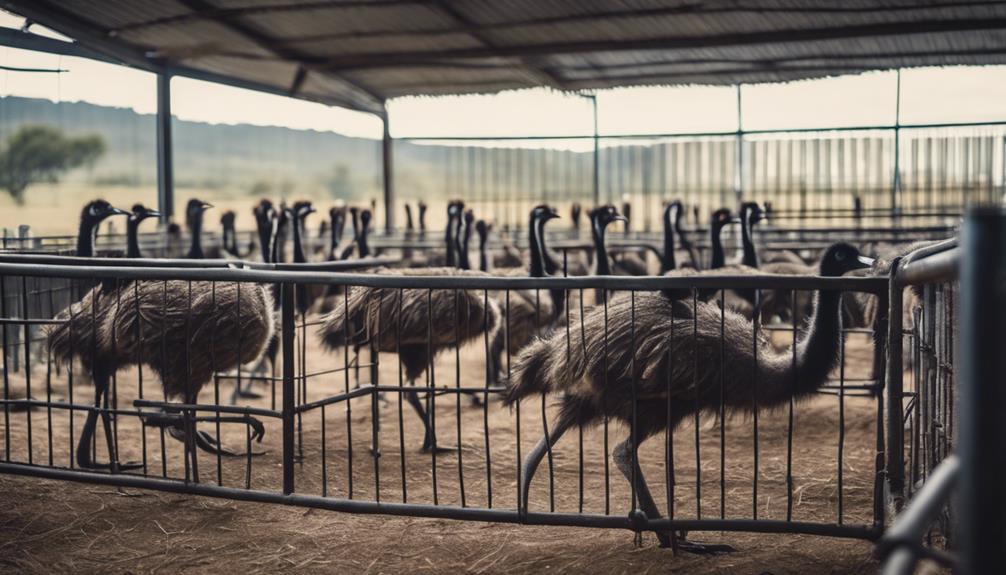
Establish designated handling and sorting areas within your emu farm layout to streamline operational efficiency and maintain cleanliness standards. These areas should be strategically located for easy access and flow of emus during handling procedures. Design pens or enclosures with sturdy fencing to safely contain the emus during sorting activities. Ensure that the handling areas are equipped with proper lighting for clear visibility and designed to minimize stress on the birds.
Utilize sorting chutes or alleys to direct emus to specific areas for sorting based on age, size, or other criteria. Implement a system for easy identification of individual emus, such as leg bands or tags, to facilitate accurate sorting. Designate separate areas for handling sick or injured birds to prevent the spread of disease within the flock.
Incorporate facilities for weighing, tagging, and performing health checks within the handling and sorting areas. Install equipment such as scales, restraint devices, and medical supplies to efficiently manage these tasks. Maintain a clean and organized environment in these areas to uphold biosecurity measures and ensure the well-being of your emus.
Nesting and Breeding Spaces
Consider implementing a systematic layout for nesting and breeding spaces on your emu farm to optimize productivity and ensure the well-being of your emus. When planning these spaces, allocate at least 100 square feet per breeding pair to provide ample room for courtship displays and mating behaviors. Construct shelters that offer protection from extreme weather conditions and predators, ensuring they're well-ventilated and have soft bedding materials for egg incubation.
Install nest boxes or platforms elevated off the ground to mimic natural nesting behaviors. These should be spacious enough to accommodate the female emu comfortably during egg-laying and incubation. Additionally, incorporate barriers or dividers to create secluded areas that offer privacy and reduce disturbances during the breeding season.
Regularly monitor the nesting and breeding spaces to maintain cleanliness and check for any signs of distress or health issues among the emus. By creating a conducive environment that meets their natural instincts and comfort needs, you can enhance breeding success rates and promote the overall welfare of your emu flock.
Health and Quarantine Zones
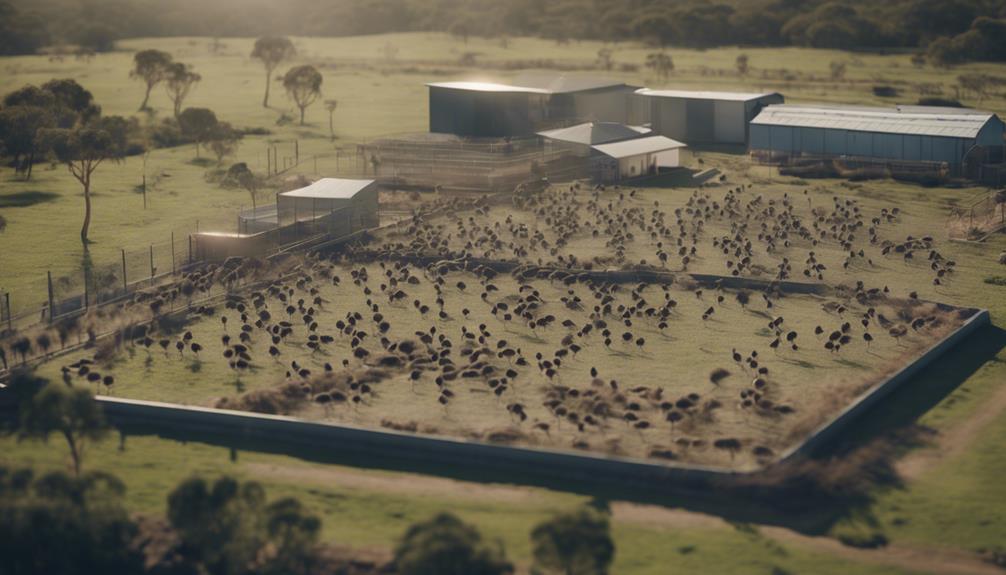
Implementing a robust system of health and quarantine zones is crucial for maintaining the well-being and biosecurity of your emu farm. Health zones are designated areas where healthy emus reside, ensuring they're protected from potential diseases. Quarantine zones, on the other hand, are essential for isolating sick or new emus to prevent the spread of illnesses throughout the farm. When designing these zones, consider factors such as adequate spacing, ventilation, and access to clean water sources.
In the health zone, regular health checks by a veterinarian are paramount to detect any signs of illness early. Additionally, strict biosecurity measures should be enforced to minimize the risk of disease introduction.
Quarantine zones should be located away from the main emu population and have separate equipment to prevent cross-contamination. Proper waste management and disinfection protocols are crucial in both zones to maintain a hygienic environment. By implementing effective health and quarantine zones, you can safeguard the health and productivity of your emu farm.
Future Expansion Planning
Ensure that your emu farm's layout and design accounts for future expansion by strategically planning and allocating space for increased emu populations and infrastructure development. To facilitate growth, designate specific areas for potential expansion of pens and shelters.
Consider the natural flow of your farm, ensuring that new structures seamlessly integrate with existing ones to optimize efficiency and productivity. Implement a scalable water and feeding system that can accommodate a larger number of emus as your farm expands.
Plan for additional storage facilities for feed and equipment to support a growing operation. Factor in space for breeding programs, egg incubation, and veterinary care facilities to meet the demands of a larger emu population.
When designing access roads and pathways, allow for future widening or extensions to accommodate increased traffic and larger vehicles. By incorporating these considerations into your layout and design, you can proactively prepare your emu farm for expansion while maintaining a powerful and efficient operation.
Frequently Asked Questions
How Do Emus React to Different Types of Music?
When studying how emus react to different types of music, observe their behavior closely. Emus may display varied responses to music, such as heightened alertness or calmness. Experiment with different genres to determine their preferences.
Can Emus Be Trained to Perform Tricks?
You can indeed train emus to perform tricks. These intelligent birds have been known to respond well to positive reinforcement methods. Emus can learn to follow commands, interact with props, and showcase their impressive agility.
What Are the Best Enrichment Activities for Emus?
To ensure optimal emu enrichment, focus on activities that promote natural behaviors like foraging, dust bathing, and social interaction. Utilize puzzles, hanging feeders, and objects for pecking to engage emus mentally and physically.
Do Emus Have a Preferred Nesting Material?
When considering nesting materials for emus, it's essential to comprehend their natural instincts and preferences. Emus often favor soft vegetation like grasses and leaves, as they provide comfort and insulation for their eggs.
How Do Emus Interact With Other Animal Species on the Farm?
Emus interact with other animals on the farm by establishing their territory through vocalizations and body language. They may show aggression towards unfamiliar species but can coexist peacefully with proper planning and management.
Conclusion
As you stand at the heart of your meticulously planned emu farm layout, envisioning the future growth and prosperity of your flock, a sense of satisfaction washes over you.
The pathways lead seamlessly from one functional area to the next, the feeding stations are strategically placed for efficiency, and the nesting spaces are inviting for future generations of emus.
Your farm is a harmonious blend of design and functionality, a testament to your dedication and vision.




